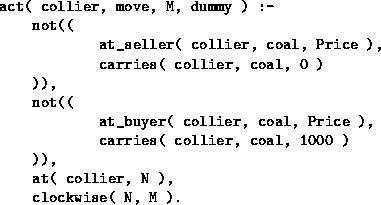
At the end of the skiing example in Supplement 1, I talked about the importance of writing mutually exclusive rules and showed two that aren't:

The problem with non mutually-exclusive rules is that they are logically inconsistent, since they state that two inconsistent things are both true. Logically, if the skier above could do a maximum of 13 pressups, he would have to be of both poor and good fitness!
Similarly, in COLLIER,

the third rule, taken logically, states that ``For all N, if the collier is at N, his act must be a move to the next clockwise square M''. This is inconsistent with the preceding rules which say that sometimes the act must be to buy or sell.
So why does this work? The reason is that, as mentioned at the end of
Lesson 5, Prolog works through the clauses from the top down, and
chooses the first one that succeeds. It may later
backtrack and
look for another solution, as it did with loves(X,Y) in
loves(X,Y), Y \= mary.If this were to happen in either of the knowledge bases above, it would indeed produce two mutually inconsistent solutions: a fitness that's both good and poor, or an act that's both a move and a buy (or sell).
This doesn't matter in Traveller, because I have written the
program surrounding act
so that it swallows the first solution act
yields up, and does not backtrack and ask for any others. Hence you can
get away with mutually inconsistent rules, as long as you remember that
they are tested from the top down, the first solution coming from the
first clause to
succeed. I have written all the examples used with the Tutor so
that this is true.
However, you should be aware that this is a departure from logic, and
that we're using Prolog's execution order to resolve inconsistencies.
This will become obvious if you load COLLIER,
move the third clause
to the top,
and then call run.
There are various ways around the problem of inconsistencies. The purest approach is always to write conditions in full. Were we to do so with COLLIER, the third rule would become

Here I have used not
(mentioned briefly in the animals classifier of
Supplement 4) to negate the first two conditions. This approach is
logically good because the third rule now carries with it all the
information it needs, and no longer has to rely on its position relative
to the others. It makes the program easier to read, because a reader can
understand the third rule in isolation, without having to examine the
preceding ones.
Unfortunately, writing all conditions in full can result in very long-winded programs, and in inefficiencies. This is because Prolog has to test some conditions more than once. An alternative approach is to use a special symbol called cut and written as an exclamation mark:

Textbooks often make a great fuss about the cut, trying to give the impression that it is rather more complex than, say, quantum mechanics, or the justification for monetarism (the first is false; the second may well be true). In this context though, there's no mystery. The cut tells Prolog ``when you have got here, do not consider any alternative solutions''. So the first cut is saying, in effect, ``if buy was one solution, sell and move are completely ruled out''.
You can test cut's effect by setting up collier's load and position
(using at
and carries)
so that he is at a retailer with a load to sell.
Then ask the question
act( collier, Act, Arg1, Arg2 ).and reply
y every time Prolog asks whether you want another solution.
Without the cuts, you will get two solutions, a sell and a move. With
them, only one.
This is one of cut's two uses; in the other, it's inserted between goals to stop the earlier one backtracking. I shall say no more about cut until the final lesson. In the meantime, I may write rules that look inconsistent, but I will rely on any predicates that call them never to ask for more than one solution. You may do the same ...but you should know when you are doing it.
When I return to the cut, I shall present it as a kind of internal ``if'', which can be used in writing predicates that perform one action or another depending on the result of a condition. This will be a fiction, but a benign one: as long as you follow the programming style I recommend, no problems will arise.